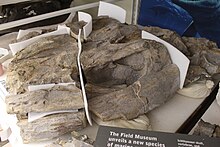Thalattoarchon
| Thalattoarchon | |
|---|---|

| |
FMNH PR 3032)
| |
| Scientific classification | |
| Domain: | Eukaryota |
| Kingdom: | Animalia |
| Phylum: | Chordata |
| Class: | Reptilia |
| Order: | †Ichthyosauria |
| Genus: | †Thalattoarchon Fröbisch et al., 2013 |
| Type species | |
| †Thalattoarchon saurophagis Fröbisch et al., 2013
| |
Thalattoarchon is a
As an ichthyosaur, Thalattoarchon had
Discovery and naming
The only specimen of Thalattoarchon was discovered in 1997 by the paleontologist Jim Holstein during a field expedition in the
It was in 2013 that this specimen was designated as the
Description

The describing team estimates the size of Thalattoarchon at over 8.6 meters (28 ft) long, making it one of the largest known ichthyosaurs. Its size and
Skull
The skull of the only specimen of Thalattoarchon is partially preserved, missing the entire
The
Postcranial skeleton
Although the total number of vertebrae is not known in the animal, it is estimated that it would have had at least 60 in the presacral
The caudal vertebrae of Thalattoarchon are laterally flattened and are twice as tall as they are wide, gradually decreasing in length. Large facets for the haemal arches, or chevrons, are present on the anterior caudal vertebrae. The animal's tail appears to be rather straight, having visibly no curvature and not having a turned-down end.[4]
Few bones are preserved in the pelvic girdle and hind limbs, the only one fully preserved being the right ilium. The end of this bone participating in the hip socket is similar to that of Cymbospondylus, but its articulations with the sacral ribs may have been rather weak, as suggested by its pointed upper end. The femur is flattened and broad, having a slightly narrowed body and an enlarged distal end, being on the whole broader than that of Cymbospondylus. Another preserved bone is interpreted as a zeugopodial element (the part of a limb corresponding to either a forearm or a leg), but it is uncertain whether it is a tibia or a fibula. Regardless, it has a concave margin, enlarged ends, and is wider than long. The hind limbs and the pelvic girdle are proportionally small in relation to the body of the animal, with just the length of the femur being twice the height of the caudal vertebrae.[4]
Classification
In the
The following cladogram shows the position of Thalattoarchon within the Ichthyosauromorpha after Sander et al. (2021):[12][5]
Paleobiology
Due to its bicarinate, cutting teeth and its large, robust head, Thalattoarchon is recognized as having been an apex predator. The abundant presence of marine reptiles within the Favret Formation suggests that the animal would have regularly attacked them. Its position as an apex predator is comparable to that of current orcas, because its cutting teeth would have been adapted to attack prey of considerable size, possibly even larger than Thalattoarchon itself, in the same way as killer whales.[1][2][3][6] However, large ichthyosaurs like Cymbospondylus would not have been Thalattoarchon's primary target; the generally preferred prey would be medium-sized marine reptiles or juveniles instead.[4] In 2021, Sander and his colleagues suggested that if Thalattoarchon would have fed on Cymbospondylus, it would have preyed on it using a pack-hunting strategy, a behavior that is not at all reported in the fossil record. The authors of this study also suggest that Thalattoarchon would have only fed on smaller animals, both alive and dead, a feeding strategy comparable to that of the great white shark. Due to its apex predator adaptations, Thalattoarchon would not likely feed on ammonites, squid, or even fish.[5]
Palaeoecology
Thalattoarchon is known from the Favret Formation, which, along with the Prida Formation, constitutes one of two recognized geological formations of the Star Peak Group, located in Nevada. These two formations are linked by a single member, known as the Fossil Hill Member. In the Prida Formation, this member outcrops west of the Humboldt Range, and extends to the Favret Formation, outcropping in the Augusta Mountains,[13] where it reaches up to more than 300 metres (980 ft) wide.[14][5] Although they are neighbors, the two formations do not share precisely the same age, the Prida one dating from the Middle Anisian, while Favret dates from the Late Anisian,[14] between approximately 244 and 242 million years ago.[5]
The significant presence of marine reptiles, ammonites and other
See also
- List of ichthyosaurs
- Timeline of ichthyosaur research
Notes
References
- ^ PMID 23297200.
- ^ a b c Riley Black (January 7, 2013). "Sharp-Toothed Thalattoarchon Was the First Ruler of the Triassic Seas". National Geographic. Archived from the original on May 7, 2021.
- ^ Field Museum (January 7, 2013). "Giant fossil predator provides insights into the rise of modern marine ecosystem structures". ScienceDaily.
- ^ .
- ^ .
- ^ a b Ryan Marek (2015). "Fossil Focus: Ichthyosaurs". Palaeontology Online. 5: 8. Archived from the original on 18 January 2021. Retrieved 13 June 2020.
- S2CID 85621052.
- PMID 27211319.
- ^ S2CID 90912678.
- PMID 32385319.
- PMID 33996277.
- ^ S2CID 245444783.
- ^ S2CID 129115608.
- ^ S2CID 219078178.
- S2CID 133180790.
